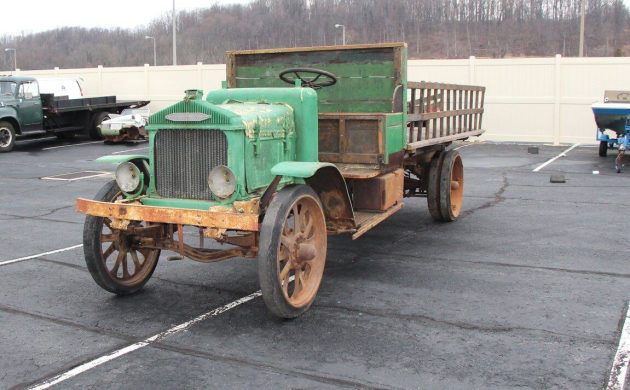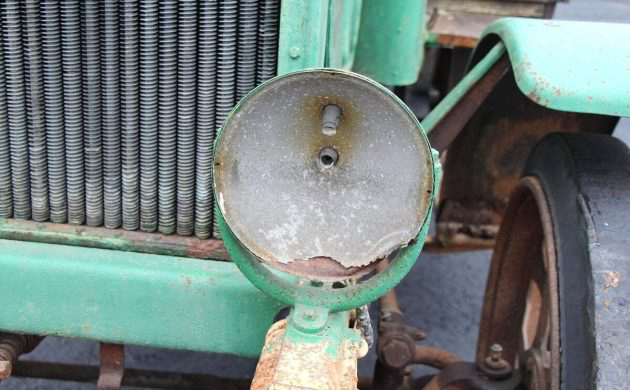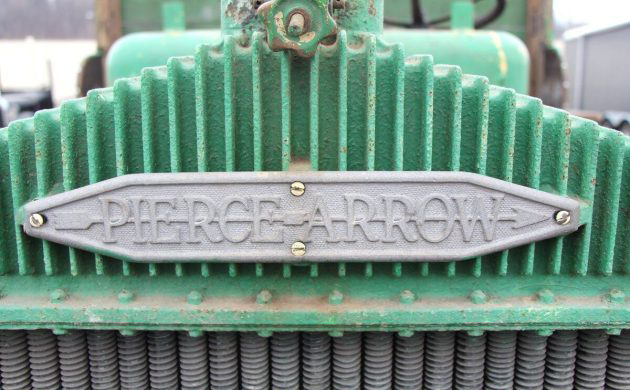Trucking Old School: 1923 Pierce-Arrow Truck
We are lucky to live in a country where you can see many examples of cars and light trucks in America’s history by going to a show or reading websites like Barn Finds. Commercial trucks are a different story. While there are plenty of examples of half-ton pickups from the past running around, the larger the truck the fewer the survivors. T.J. has found a great example of what big trucks used to be. Take a look at this 1923 Pierce-Arrow flatbed truck for sale on eBay in Morgantown, Pennsylvania. This huge beast is a rare and fairly complete example of an early commercial truck that emerged from the factory the year Calvin Coolidge took office. With an $8,000 price tag, does this big Pierce have a chance at finding a loving home today?
Every once in a while, a video pops up on Facebook or YouTube that shows big city street scenes from back in the teens and twenties. Some of those film-to-video pieces depict the mundane comings and goings of people, animals, and vehicles. This was a time when the horse was fast disappearing as transportation and a source of propulsion for wagons. They were being replaced by cars and trucks, with the big jobs going to trucks that would be all but unrecognizable to truckers today. Watching them is a fascinating look at how we did things back then.
The trucks we see in these videos were built to do heavy work almost exclusively in towns and cities. They rarely ventured more than a dozen miles from their home base. Anything big needing long distance delivery would be transported by rail from city to city and town to town through a rail network farther reaching than the one we have now. Interstates didn’t exist then and long, paved roads were being built, but were still a rarity. Once those big things got to a city, they were offloaded at the freight yard and/or at a freight depot. Just as a commercial truck picks things up from a warehouse now, these commercial trucks would show up to carry the cargo to its final destination.
The big difference is how the truck operated. Despite being much larger in displacement in many cases than the trucks that roam the roads today, these vehicles didn’t put out a lot of horsepower over their limited RPM range. What they did produce was plenty of torque. So, they were geared very low to take advantage of that torque to move heavy loads. That low gearing didn’t produce much in the way of speed. This lack of speed and limitations on the load capacity of the tubed tires of the day necessitated solid rubber wheels. When you consider the technology of the day, these trucks performed their job very well.
Sadly, the march of that technology soon rendered trucks like this 1923 Pierce-Arrow to the scrapyard. They were too slow and cumbersome for a more modern America. Drivers dared to demand creature comforts beyond open or barely enclosed cabs, and many of the companies that produced these behemoths stopped producing parts or vanished altogether. While older cars sometimes were lucky enough to find refuge among people who admired them, the situation is altogether different for a big, slow truck that was hard to drive and even harder to keep out of the elements. Almost all of the ones that survived until World War II fell prey to the home front’s numerous scrap drives.
The good news is that a few of these trucks still inhabit the back lots of long-forgotten junkyards and are sought out by commercial truck collectors. If one of these beasts has made it to the year 2023, its chances of resurrection are good. While large and cumbersome, they can be easy to at least cosmetically restore. Also, consider that a modern machine shop can reproduce almost any part on one of these trucks if given the proper time and financial incentive. Seeing a truck like this Pierce-Arrow running and driving at a major meet like Hershey is a treat. They are an important part of America’s history that few understand.
What you see here is a fairly rare example of what probably kept Pierce-Arrow as a commercial concern afloat financially during the twenties. Pierce-Arrow is far better known for its luxurious passenger cars. However, they were experts at making high-quality engines capable of producing the power needed for commercial vehicles such as trucks and fire engines. The truck you see here is a three-ton rated model with a 447.9 cubic inch engine. It has four cylinders, and it runs on gasoline. That engine is seized at the moment, so you won’t be able to take a test drive.
That test drive would surely test your upper body strength, as vehicles of this era had no power assists of any kind. Steering wouldn’t be your only difficulty. The body and the seat were made of wood and likely had little padding back in the day. The headlights were early acetylene instead of electrical, and the engine may have even required hand cranking. Imagine trying to get out of the way of the crank handle when it finally kicked over.
So, who would want such a vehicle? Believe it or not, there are a lot of folks out there who enjoy restoring and demonstrating trucks like this. Most of those folks are farmers who take them on as winter projects. Some even put them back to work doing tasks around the farm or shop. Florida Power still has a Mack Bulldog from the era that is used in parades. Even that old geezer of a truck gets pressed into service occasionally after hurricanes. It can still be found doing the job it was originally purchased by the company for of setting power poles. Just because these trucks are slow and antiquated doesn’t mean they can’t still put in a day’s work.
Would you be interested in restoring such a beast? Would you drive it and display it, or just keep it around the shop? Please share your thoughts in the comments.
Auctions Ending Soon
 2002 Subaru Impreza WRXBid Now2 days$333
2002 Subaru Impreza WRXBid Now2 days$333
 1975 Chevrolet Corvette ConvertibleBid Now2 days$4,000
1975 Chevrolet Corvette ConvertibleBid Now2 days$4,000
 1964 Ford F-100 Camper CustomBid Now2 days$2,000
1964 Ford F-100 Camper CustomBid Now2 days$2,000
 2006 Jeep Wrangler SportBid Now4 days$10,500
2006 Jeep Wrangler SportBid Now4 days$10,500
 1974 Datsun 260ZBid Now6 days$750
1974 Datsun 260ZBid Now6 days$750







Comments
Wow, I must say, a tip of the hat to the author, I can’t, nor want to add much. Couple things though, most, if not all the ones “in back lots” are long gone. The only way anything like this survived, is it was in a building and forgotten about. As you drive across this still great land, just look at all the abandoned places. That’s where this stuff comes from. P-A, as mentioned, was a leader in technology, and this truck, for 1923, is surprisingly modern. It has an electric start, generator and electric headlights, looks like bulbs, don’t ask me what kind of fuel intake that is, I think it’s missing something. I don’t think it has a 2 speed axle, it’s just a top load type, amazingly, still used today. Okay, the brakes are mechanical,, on the rear only, and probably takes Jethro Bodine to stop it, but also as mentioned, travel was slow, and within city limits, and was adequate for the time. Solid tires too. I heard stories from MY mentors that said, a tire could lose a big chunk of rubber, and they would have to finish the day anyway. Think of that shopping cart you always get with the square wheel. Solid tires were still used well after air tires for local or inter plant stuff. Even today, many “severe duty” industrial machines are going back to solid tires.
Yes sir or ma’am, this was a mighty fancy truck for the time, kind of the “Peterbilt” of its day. I had a cushy job compared to these pioneer drivers, but like anything, they had nothing to compare it to except the past. I have no idea what to do with it and with no viewers or bids, apparently nobody else does either.
Special thanks to Jeff for writing up this fantastic piece of history.
Agreed. Jeff did a great job weaving in the historical realities of the time with the specs of this truck.
There must be a P-A museum that could take this on.
These were quite the trucks in their day. I’ve seen two in the flesh and I saw a pic of what I was sure was on in Hemmings Classic Car a few years back. Obvious P-A kept its usual period truck styling but when I saw the one in Hammings it was late enough to have incorporated some of the car’s styling that extended to the headlight buckets morphed into the front fenders. Sure would like to see that in the flesh today. I have found a couple of pics in my collection, one not too much later and the other, courtesy of Hank Suderman but nothing that showed a hint of the Art-Deco styling that was to come later.
What to do with a truck like this? Well, it’s a little too rich for my blood. There was a truck collector up towards Calgary in Canada, whom if he was still around, might jump at the chance. The included pic is from his collection…
Two big thumbs up to our duo of Truck Guys for bringing it about this cool old P-A.
These trucks only made short local trips I think not. Now let me tell you like it was told to me by my father. My father was born in 1934 at the age of 16 after finishing the 10 grade he started trucking. He hauled steel and made a lot of trips to buffalo NY. He met an old trucker in buffalo and he took a liking to my father. He told my father about trucking when he was a young man driving a truck similar to the one here. He said it took a week to go from buffalo to New York City. Imagine what that trip was like in an open cab in the winter. Even with side curtains the only heat was what was coming off the engine. These old trucks were real work horses in there day and so we’re the driver’s. They both have my respect as they deserve it. Good luck to the seller and to the buyer enjoy it and show it some love and respect.
Thanks, H, I always enjoy stories these posts conjure up. If I may, what the author meant was there was little, if any, cross-country trucking like today. With some exceptions,the train handled all long distance shipping, to rail depots in cities, and the trucks took it to the customers. Many times local, but what you describe was more of a regional thing, where there was limited access to the rail. Of course, no truck post like this isn’t complete without mention of my favorite movie, “They drive by night”. It was made in 1940, but depicted trucking in the 30s,(?) and from what I read, was spot on. When Joe punched the broker, it was priceless. Always wanted to do that. Brokers a bunch of crooks, they were/are. It featured many trucks like this in a local, city setting shots. The Fabrini brothers had a late 20s Sterling, and ran up and down the coast of California, kind of what your dad did, only on the other side.
We’ve certainly come a long ways in that regard, with the “rolling apartments” of today, and communication, but we can’t forget, I hope, it wasn’t always that way, and took a special type of person to do the job. I’m happy to say, back then, I could have easily been that person.
Unless your a museum with restoration facilities, a wealthy trucking magnet that wants a unique company marquee or the final, a rich eccentric collector that loves parades and hauling drunken Shriners. There really much more to do with this long forgotten fella.
What is that control/valve knob on top of the radiator? ie: What does it do?
That what we call the “radiator cap”. It’s where you add water/antifreeze to the radiator on water-cooled engines, which prevents them from overheating.
Hi Kenn, well, GitterDunn pointed out the obvious, what that is, is before radiator caps had the familiar 2 step removal, that screw held the cap in place. It’s missing the “ear” it would connect to.
That Pierce Arrow emblem on the radiator looks like a sandcast replica held on by shiny new screws too. I was surprised this isn’t chain drive but what do I know??
I came for Howard and Geomech’s insight. Was not disappointed.
Thanks, pal, to be clear, Geomechs has forgotten more than I know,,:)
And those solid rubber tires? Ouch,
Please someone contact the Iowa 80 truckstop in Walcott, Iowa. Largest truckstop in the world and they also have a truck museum. I’m sure they would be interested in this truck! I don’t know how to transfer this article to them or I would. I hope someone can do that because they will give this truck new life and love.
That’s a great idea. Bill Moon, who was one of the founding fathers of ATHS, died in 1992, but the family still owns the facility, and still has many of Bills trucks on display. Whether they have the resources to take on a project of this kind is doubtful.
I have long suggested that the country adopt rubber highways ad cement wheels. Just think about it … no more or running to the tire store … just cast a new wheel (no tires) when needed. The Government can just recap the road. certainly cheaper than paying for miles and miles of ceemennt!
Not nearly speedy enough for todays roads, but with that vast cargo bed, stout build and 3-ton load rating, I could see this old girl gone thru mechanically, and put back to work hauling feed, etc. on a farm or ranch. That would be a far more dignified fate than gathering dust in a museum, being a static advertising display or hauling drunken Shriners in a parade!
My back is screaming for ibuprofen just at the thought of driving this ancient beast on the roads they had back in the 20’s. I bet those old timers had their doctor on retainer for tons of laudenom and morphine. That, or they retired at 35. Thank sweet baby Jesus my bus has an air-ride seat!
But seriously- I hope someone saves this old workhorse for posterity, there can’t be more than a few left in the world these days.
Great write up!
As a western NY resident, I’m surprised to see so many inquiring who may want this or if there’s a museum. There is and I already contacted them about this, even though I’m sure they’re already aware of it. One of the few reasons to visit;
https://pierce-arrow.com/
It’s big. It can’t be fun to drive for even a short distance. But it sure is cool.
It would make a great static display as is. If you have the room.
This is just because I forgot to click on the get updates.